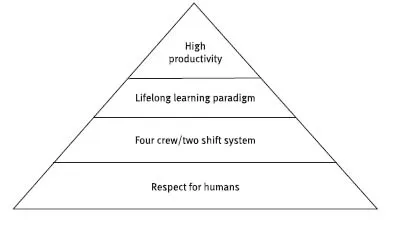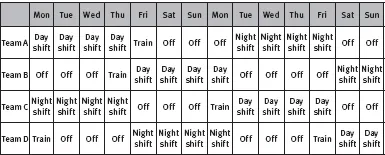The human resource consulting company Hewitt Associates, sponsored by The Wall Street Journal Asia, ranked Yuhan-Kimberly among the top ten companies on their list “Best Employers in Asia” in 2003. Mr. Seung-woo Son, the manager of public relations at Yuhan-Kimberly, attributes the foundation for such success to the corporate culture of Yuhan-Kimberly (Y-K).
The corporate culture of Y-K, in turn, is derived from the business philosophy of the company founder, Dr. Il-han New. Its five business principles are “respect for humans,” “customer satisfaction,” “social responsibility,” “value creation,” and “innovation orientation.”
This case traces the impact of Y-K’s first principle, “respect for humans,” upon company success. In few words, the first principle implies that Y-K does not consider employees as raw materials for production (i.e., as a business cost), but considers employees as family members who can all grow together.
The “four crew/two shift system” and “lifelong learning paradigm” at Y-K is a result of the application of the first business principle. And Y-K believes that this principle is directly related to its high productivity, as shown in figure 1.1.
Figure 1.1
“Respect for humans” pyramid
Most observers agree that the economic success of Y-K can be partially explained by its application of its foundation principle: “respect for humans.”
Kook-Hyun Moon, the former CEO and president of Y-K, is emphatic in his belief that organizational restructurings and large layoffs are old and unproductive practices. He argues that most leaders in the current business environment do not understand that the new practice of investing in employee development is the most beneficial one that an organization can adopt.
FOUR CREW/TWO SHIFT SYSTEM
One of the events that led to an application of Y-K’s “respect for the individual” principle was its need to shut down some of its production lines for more than six months during the Asian economic crisis of the late 1990s (approximately 1997–1999).
Operating time at Y-K’s manufacturing plants was reduced by more than 50 percent during this period. Organizational restructuring seemed to be Y-K’s only solution. But talk of restructuring created tension between labor and management.
“Redundant employees” comprised approximately 40 percent of the total labor force. For most businesses, this excess-labor percentage would mean a large number of layoffs. However, Mr. Moon came up with an innovative solution to the problem.
Instead of a large layoff, Mr. Moon suggested a job-sharing system, a system that came to be known as the “four crew/two shift system.” The system could have led to even greater financial difficulties because its implementation actually increased its labor costs. However, Mr. Moon believed that application of Y-K’s human principle and the decision not to lay off Y-K’s employees would overcome increased costs.
In the beginning, employees were opposed to the new system because they feared reduced wages as a result of decreased overtime pay. However, employees started to accept the new system as the Asian economic crisis worsened.
Under the system, a team works the day shift for four days, from 7:00 AM to 7:00 PM and another team works the night shift for four days, from 7:00 PM to 7:00 AM. After four days, another set of two teams takes over the two shifts and the previous two teams have four days off (3 days of rest and 1 day of paid training).
Figure 1.2
Four crew/two shift system schedule
Figure 1.3
16 workday cycle
The “four crew/two shift system” started to show positive results almost immediately. A dramatic leap in productivity was realized by these employees, who now were able to take long enough rest periods to achieve full recovery and then had enough time for continuous training and education, all without Y-K ever having to halt production lines.
As a result of the system, fiscal revenue more than doubled, from U.S. $332 million in 1996 to U.S. $704 million in 2003. Also, net income increased sixfold, from U.S. $14.4 million to U.S. $90.4 million, during the same period. But, initially job sharing reduced individual working hours by 150 hours per year and individual salaries and wages by 6 percent.
LIFELONG LEARNING—PARADIGM SHIFT
Y-K offered employees corporate-sponsored in-house educational opportunities in areas such as beginning and advanced computer skills, foreign languages, and job-related skills. Y-K also encouraged employees to further their education outside the workplace and the company agreed to support 70 percent of the cost. The implementation of the new system brought about a “life-long learning paradigm” among employees. Mr. Moon strongly believes in the importance of continuous learning to transform manual workers into knowledge workers. These workers in turn generate more ideas and are able to make more decisions on their own.
In the year immediately following implementation of the system and paradigm shift, the annual number of suggestions for improvements and innovations from workers increased by 1,200.
Beginning in the second year, the new paradigm resulted in higher productivity and higher incentive pay for individual workers. As a result, salaries and wages rose over what workers had been paid prior to the inauguration of the system. With such impressive results this innovative system was recognized as a success, because it not only increased employment but also increased the productivity and knowledge base of workers.
QUESTIONS
What in human nature accounts for the success of the Y-K rotation system? If the Y-K system is so productive and profitable, why isn’t it more widely used? What would prevent such a system from being implemented in a company with which you are familiar?
For as long as Bill Callahan could remember, he had always worked—indeed lived—in a retail store. His father had owned a small meat market in South Philadelphia, and young Bill had played there as a toddler and gone to work there as soon as he was old enough to hold a broom. He had worked in the market on weekends while going to school and college; and when he went into the army, he found himself almost immediately running a Post Exchange. And Bill loved every minute of it—indeed, his idea of heaven was a huge supermarket in which all the cash registers rang all the time.
Bill had known since he was eight or nine that he would own and build a retail chain—and he started on this goal the day he was discharged from the army in the mid-1960s. But he also knew that his chain would be quite different from any other. For Bill had deep convictions as to what makes a successful retail business. “No retailer can carry better or even different goods,” he argued. “What he can do is first make shopping more enjoyable, friendlier, and more fun; and secondly, make the retail store a place where people like to work and a place the employees consider their own personal concern.” This, according to Bill Callahan, meant three things: First, no chain could contain more than a handful of stores—no more than what one owner-manager could manage by example, by frequent visits of inspection, and by personal control. Second, each store had to have a center of strength, something that made it distinguished. And finally, the key people in each store—the manager and the department managers—had to have a personal stake in the store’s success. Callahan’s first store was a medium-sized supermarket on the outskirts of a metropolitan community; he got a very cheap rental, as the former operator had gone bankrupt. Within three months, Callahan’s store was flourishing. “All I did,” said Callahan, “was to think through the areas in which a supermarket needs excellence—its meats and produce—for everything else is packaged by the manufacturer. So I personally ran the meat and the produce departments, until they were outstanding. Then I thought through how to give distinction to a small store—and I started the first flower-and-plant department in a supermarket in my area. This completely changed the store’s physical appearance and attraction, and the department also makes a good deal of money. Finally, I knew why people come back to a store—they like the way they’re treated. So I stressed being friendly, being friendly, being friendly, until every employee got the idea.” Nine months after the first store opened, Callahan opened the second. He moved over to the new store as manager and gave his successor at the first store a substantial share in the store’s profits, with smaller shares for the department managers—all the way down to the women at the checkout counters. Within three years, Callahan had eleven stores in the same metropolitan area.
Then, instead of opening more supermarkets, he decided to start a new chain—a chain of garden centers. He repeated the pattern there—and then shifted to home-service centers for the do-it-yourself home owner, built around hand tools and small power tools. His next venture was a chain of greeting-card stores—small, high-turnover, and run by one person. Thirty years after he had started with his first store, Bill Callahan incorporated as Callahan Associates, with four chains, a total of forty stores, and in excess of $150 million in sales. Each of the chains had its own general manager who had started out as a checker or clerk and worked his or her way up through store management. Together with Callahan, a financial executive, and a human resource executive—all former store managers who had started at the bottom—they constituted the company’s executive committee. The general managers of the chains had a small profit participation in Callahan Associates and a substantial participation in the profits of their own chain. Each store manager under them had a smaller share in the chain’s profits and a substantial share in his or her store’s profits—and so on, all the way down, with every employee with more than eighteen months of service participating in some sort of profit-sharing plan.
Callahan deeply believed that the company had to expand to give people promotional opportunities. And since he also believed that no one chain should grow beyond the point where one person could easily manage it and know every nook and cranny of it, this meant going purposefully into new businesses every six or seven years. Accordingly, he started in the fall of 1995—almost exactly thirty years after he opened his first store—to look around for the next business to go into. He finally picked two as most promising: a chain of “outdoor-wear stores”—blue jeans, boots, Western shirts, and so on; and a chain of simple restaurants featuring steak, roast beef, chicken, and so on. However, he knew that he should tackle only one of these at a time. Callahan had learned how difficult it is to get a new venture going and knew that he himself would have to spend most of his time on it for the first two or three years.
It was the policy of Callahan Associa...



